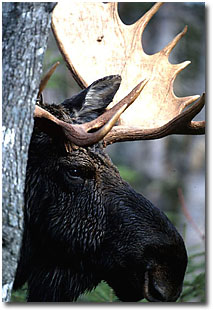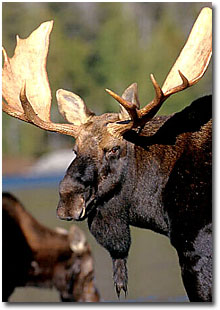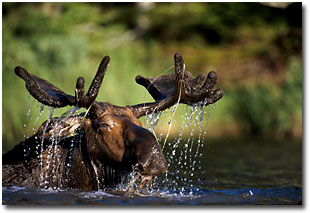|
The Camera Hunter®
Photography and Text Copyright Bill Silliker, Jr.
All rights reserved.
What is a Moose?
A recent Forum discussion about a photograph showing interaction between a bull and a yearling cow gave me the idea that it's time for an article about moose. This was excerpted from my soon to be published 4th book on moose, the Moose Watcher's Handbook. I changed a few words to better reflect our interest in photography at this site. The Mooseman
 To get the most enjoyment out of photographing any wildlife species, it helps to know something about them. When it comes to an animal as large and powerful as a moose, it is also a very good idea. While most moose normally are quite gentle, some can get pretty darned mean. Informed moose photographers enjoy not only better experiences, but also safer ones for both themselves and the moose.
To get the most enjoyment out of photographing any wildlife species, it helps to know something about them. When it comes to an animal as large and powerful as a moose, it is also a very good idea. While most moose normally are quite gentle, some can get pretty darned mean. Informed moose photographers enjoy not only better experiences, but also safer ones for both themselves and the moose.
What exactly is a moose? Let's look at some of the questions that rookie moose watchers often ask before we try to answer that one -
What Family Of Animals Does The Moose Belong To?
Moose are actually deer. Their relatives include the elk, the caribou, the mule deer and the white-tailed deer all also found in North America.
Moose are in fact the largest deer in the world. And moose inhabit a lot more of the world than one might think. They also live in Europe and Russia. While those moose are called elk, they are all moose at heart.
Why do the animals living in North America have a different name? Because the Indians native to this continent gave the moose its North American name. Moose means "twig eater" in the Algonquin language. That name provides a clue to one of the more important things that a moose photographer should know.
What Do Moose Eat?
Moose eat the twig ends of trees, and with tastes that cover a wide variety of trees. Mountain ash, maple, birch and balsam fir are all part of their diet.
They also eat the leaves and sometimes the bark of trees. And they love aquatic vegetation as well. Pondweed, water lily, arrowhead and such underwater delicacies provide moose with nourishment and minerals that are important to both antler growth and milk production.
But if you're worried about being attacked by a moose as a food source, you're safe. Moose are not carnivorous.
And for those who have speculated while watching a moose repeatedly submerge its head in some pond about how many fish a moose eats in a day, here's the facts: moose do not eat fish. What they're doing is eating vegetation off of the bottom.
How Big Is a Moose?
A mature bull moose of the subspecies Alces alces Americana found in New England, and commonly called the Canadian moose, stands over 7 feet tall at the shoulders. Its legs might be 40 inches long. The adult moose measures about 10 feet long from the end of its nose to the tip of its tail.
The average mature Canadian bull weighs from about 1000 to 1200 pounds, and can weigh as much as 1400 pounds or more. The subspecies of moose that live in Alaska are even larger. An Alaskan bull moose might weigh as much as 1800 pounds!
Cow moose are almost as large as the males but they generally weigh less.
 Do Moose Live In Family Groups?
Do Moose Live In Family Groups?
Moose families consist of a mother and her young. The family may be a single calf, often is two calves and on rare occasions, may be three. An extremely rare case of a moose mother with four calves has been recorded.
While a bull moose shows much adoration as he courts a cow during the fall, he abandons her not long afterwards and never shows any interest in his offspring. In fact, bulls avoid getting near moose babies because they come with one of the most protective mothers in the animal kingdom.
Moose are born from mid to late May. Moose babies stay with their mothers through their first year. But when spring comes again, mother moose break up the family by chasing off their yearlings. A pregnant cow moose needs all her energies to raise another youngster. An occasional lucky calf whose mother is not pregnant will be permitted to follow mother after its first birthday. But either the mother or an amorous bull will chase it off as a rival when the fall mating season arrives.
Do Moose Talk To Each Other?
Moose grunt to each other in a low-pitched, "uunnhhh", a grunt made by both bulls and cows. It means different things depending upon who says it, when they say it, and how.
Moose photographers can benefit by knowing the sounds moose make to each other. Some might even want to try to bring moose closer by imitating their calls. Only those who really know moose behavior should ever consider this, and then only where it is legal to do so. National Parks in the United States and some other jurisdictions do not permit calling wildlife.
Mother moose grunt a variety of messages to their calves: follow me, stay here, it's not time to feed yet, it is time to feed and so on. If you ever watch a cow grunt different messages to her calf, you'll be amazed at how well the little moose understands.
Mature bulls generally don't vocalize until the fall mating season. Then they grunt either as a greeting or as a signal that they're looking for a mate. During the peak of the rut, bull moose become very vocal as they prowl the woods.
Cow moose moan a "weeaahhhoowww" wail during the rut. It's a signal to bulls that they are in estrus and are willing to mate. Simulating this call can really attract the attention of an amorous bull. If you try it, be sure to have a climbable tree handy!
Do All Moose Have Antlers?
Only the bull moose grow antlers. Moose antlers are deciduous: they grow every year, beginning in the spring. Moose five or more years old generally grows the real "racks" - the palmated antlers that most folks think of as moose antlers. A Maine moose rack from 1900 measured 71-5/8 inches across - almost 6 feet. And the current world's record is from an Alaskan moose that had over an 81 inch spread!
 Bull moose use their antlers to show females that they are healthy breeding stock. They also use them to deter other bulls from messing with their cows during the fall mating season - it's a guy thing, you know?
Bull moose use their antlers to show females that they are healthy breeding stock. They also use them to deter other bulls from messing with their cows during the fall mating season - it's a guy thing, you know?
The moose rut begins in mid-September and runs into mid-October. Bull moose get pretty cranky as the rut proceeds. In fact, they get downright cantankerous. Some do battle with trees and telephone poles, and some have even attacked parked cars and trucks. It's the time of year to stay well away from any bull moose.
A bull that feels threatened by the proximity of a younger animal will thrash his rack of antlers around, toss his head to display his strength and grunt a challenge while doing so. If you're ever watching a bull moose during the fall and he does that for your benefit, find a tree to climb - fast!
Two evenly matched bulls will often spar and may actually fight seriously in real head whacking wars. While most moose battles end with one of the bulls running away, some bulls have fought to the death for the rights to the pleasures of a cow moose.
A bull moose during the rut can be one of the major animal forces in nature.
Are Moose Dangerous?
Any animal that weighs half a ton or more, stands seven feet at the shoulder and has its own "bad hair days" at certain times of year certainly can be dangerous. Moose stomped two people to death in separate incidents in Alaska in the mid 1990's. Surprisingly, both human fatalities occurred in suburban areas, not out in the big woods as one might imagine.
That's not to say that you should fear moose. But you should have a healthy respect for these large and typically quite timid creatures because of their size alone. And you should know that certain moose at certain times of the year require even more respect. Those moose - mothers with calves and aggressive bulls during the mating season - deserve a lot of space and a wary eye.
Mother moose may be the most dangerous land mammal in North America shy of the grizzly bear. They certainly will defend their young from all comers. Should you ever get in a situation where a mother moose perceives you to be a threat: WATCH OUT!
So What Exactly Is A Moose?
A moose is a strange blend of timidity and potential unmatched fury, the true monster of the north woods that could do great damage but rarely does. A moose is a huge hairy beast that thrives by eating aquatic vegetation and twig ends and leaves. A moose is an animal that, while friendly enough when not harassed could turn on you in the wink of a big old brown moose eye. And because of all that, moose are my favorite wild animals alive on this planet today. Maybe that's why they call me the mooseman!
Catch yours in the good light.
BS-NPN
Comments on Bill Silliker, Jr.'s The Camera Hunter articles? Send them to the editor.
Maine wildlife & nature photographer Bill Silliker, Jr. – The Mooseman - photographed at many wild places in North America, with the results published in magazines internationally and in 9 of his own books. Bill was an instructor of wildlife and nature photography for L. L. Bean's Outdoor Discovery Program and a member of the Fuji Film Talent Team. Read more about Bill on the Camera Hunter archives page.


| 


